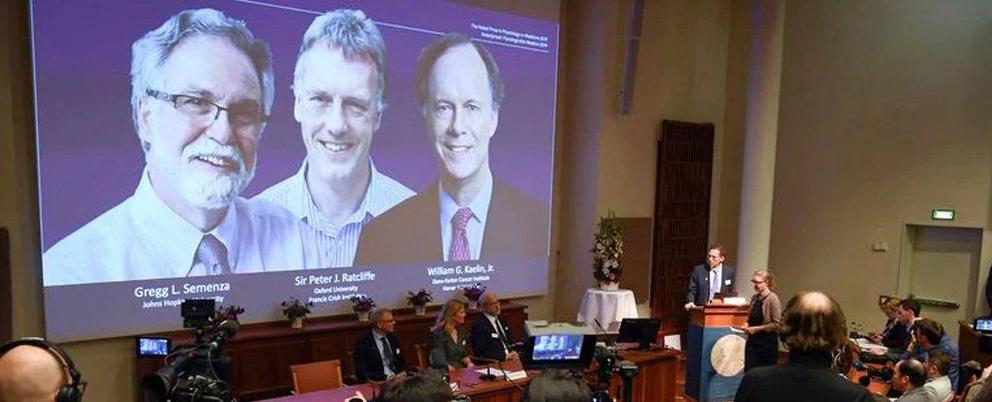Nobel Prize in medicine won for profound discovery of how cells sense oxygen
The 2019 Nobel Prize in Medicine news conference.
The Nobel Prize in physiology or medicine was awarded Monday to three physician-scientists from the United States and Britain - William G. Kaelin Jr., Peter J. Ratcliffe and Gregg L. Semenza - "for their discoveries of how cells sense and adapt to oxygen availability."
The discoveries by the trio illuminated what the Nobel Committee called "one of life's most essential adaptive processes," answering profound questions about how the body works and providing potential new therapeutic avenues to treat cancer and other diseases.
The three scientists, working independently, revealed the cascade of molecular events that allow cells to detect and respond to different levels of oxygen. That allows the human body to adapt to thinner air at high altitude by generating more red blood cells to carry oxygen.
But it can also go awry in disease, providing new targets for treatment: Cancer cells exploit these molecular switches to thrive, for example, and increasing cells' tolerance for low oxygen could offer a way to treat heart attacks and strokes.
"If you think of the main causes of death in the US, three out of five are related to lack of oxygen," including heart attack, stroke and respiratory diseases, said Isha Jain, a scientist at the University of California at San Francisco who was partially inspired to enter the field by the work being honored by the Nobel. "Understanding how the body senses and responds to low oxygen is pretty fundamental to all these diseases," she said.
The predawn phone call from Stockholm announcing the award is the induction to a very exclusive club, and it kicked off a frenzied day of media interviews, standing ovations and requests to take selfies for scientists more accustomed to spending time in the lab than in the limelight. Semenza, a professor of genetic medicine at Johns Hopkins University, told a packed auditorium of colleagues and students that his scientific inspiration was a remarkable high school biology teacher, Rose Nelson, who is now deceased.
"She used to say to us, 'When you win your Nobel Prize, I don't want you to forget that you learned that here.' She just assumed that one of us was going to do that," Semenza said. "She was my inspiration, and I think that is the importance of teachers, to serve as that kind of spark."
Kaelin, a scientist at Dana-Farber Cancer Institute in Boston, said in a telephone interview that he awoke to the 5 a.m. phone call from Stockholm, wondering at first if it was a dream.
"My heart was racing in disbelief," Kaelin said.
Ratcliffe, director of clinical research at the Francis Crick Institute in London, was writing a grant proposal when he received the call.
The work began in the 1990s, when Semenza identified genes that turned on when oxygen levels were low to increase levels of erythropoietin (EPO), a protein that increases the production of oxygen-carrying red blood cells. (This is the same basic idea behind doping, in which endurance athletes try to increase their supply of oxygen-carrying red blood cells.)
An anemia drug that increases red blood cells by targeting this basic mechanism was recently approved in China.
The scientists worked separately to understand this mechanism in cells, but they talked and occasionally shared unpublished data - sometimes at a scientific meeting, sometimes at the bar, Kaelin said.
Semenza's scientific paper describing the protein that responds to low oxygen has now been cited thousands of times, but he recalled that it was rejected from numerous top journals - a reminder that science builds on itself over time, and blockbuster discoveries that transform understanding are not instantly apparent, even to other scientists.
"We submitted to these so-called top-tier journals. They didn't find it to be of sufficient interest to warrant publication," Semenza said.
Today, some of the most exciting applications of the research are in cancer. The cells at the center of a tumor are able to thrive in an oxygen-deprived environment, far from blood vessels that carry nourishing oxygen.
Traditional chemotherapy or radiation treatments mostly kill the tumor cells on the periphery, not the ones at the center that have adapted to a low-oxygen environment, said Qing Zhang, a scientist at the University of Texas Southwestern Medical Center, who previously worked in Kaelin's laboratory. Those hardy cells that survive can metastasize to seed new cancers, one of the biggest challenges facing patients and oncologists.
"The basic question is how the cancer cells can survive the lack-of-oxygen condition, and how what doesn't kill them can make them stronger," Zhang said.
For the rest of this article please go to source link below.

